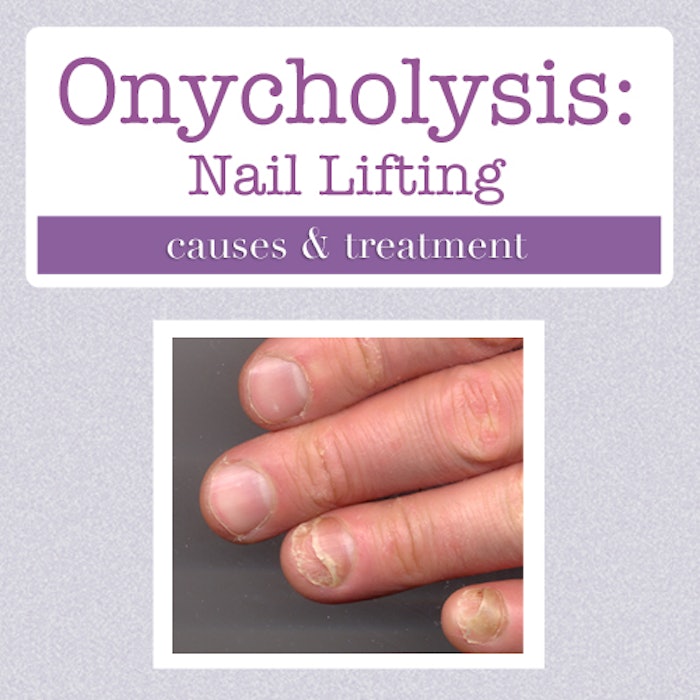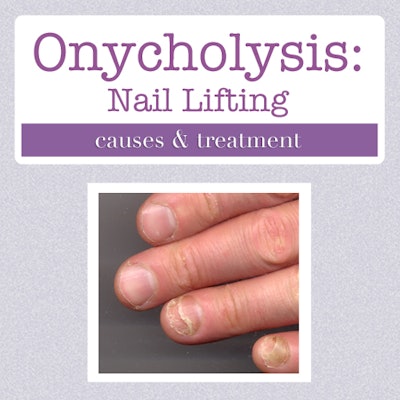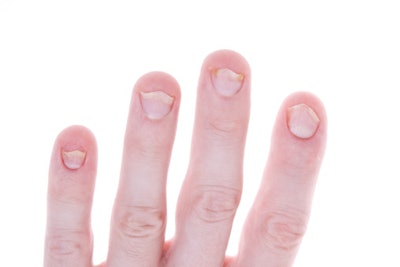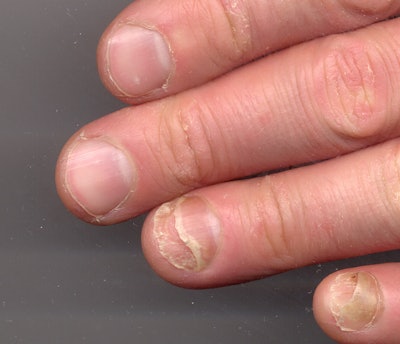

Onycholysis refers to the lifting of the nail plate either up from the underlying nail bed or in from the sides. Since it’s a pretty common occurrence, it’s a good idea to keep up on the three kinds of causes of this condition: external irritants, infections, or health problems.
As far as irritants, there are four main culprits:
Harsh soaps and detergents: Those who work in housecleaning, use harsh chemicals cleaning, or tough soaps while dishwashing are at risk.
Certain raw or acidic (like citrus) foods: Restaurant workers and those often handling food may be affected.
Frequent contact to water: Clients who are housekeepers, work in the medical field, or are new parents may be irritated by repeated water contact and hand washing.
Nail products like acrylics, acetone, formaldehyde can irritate nail techs and their clients from overexposure.

Skin problems and infections can also be a source of the problem, such as:
Psoriasis: The same skin condition that causes redness and flaking can also lead to lifting of the nail plate. Not only that, but the skin debris from psoriasis can collect under nails and actually thicken them.
Fungi: Fungal infections like dermatophyte become a problem after trauma (like a badly stubbed toe or hurt finger) lifts the nail away from the bed and allows the fungus to enter in between the two.
Growths: Warts, usually on fingernails, can affect lifting, and nail biting only spreads the problem from finger to finger. Bony growths on feet can be a factor in onycholysis on toenails. Rarely, and usually in older individuals, a tumor underneath the nail can be the cause of nail lifting in older adults.
Deeper inside the body, imbalance and disorder can be the root of onycholysis. A few of these causes include:
Candida: Chronic yeast infections paired with one of the aforementioned irritants can put a client at higher risk for their nail detaching from the nail bed.
Medicine: Certain antibiotics like tetracycline, sulfa-related medicines like those sometimes used as diuretics or to treat diabetes, some antihistamines, chemotherapy drugs, and tranquilizers like Thorazine can produce lifting issues.
Thyroid disease: An overactive or underproducing thyroid gland can cause nails to become brittle and split from the nail bed.
Lupus or similar disorders: Serious medical conditions like lupus can also be a factor in onycholysis. With 90% of lupus patients between the ages of 15 and 45 being women, lupus can be a big problem in salons.

So what do you do?
The most important thing is to treat the cause of the problem–whether it be irritant, infection, or disorder. As a nail tech, you should stress the importance of pinpointing the initial reason for the issue, as nails can be an indicator of overall health. Advise your client to see her doctor or dermatologist for the problem. Those with a yeast infection or other fungal infection should seek the medical treatments necessary to eradicate them after consulting a doctor.
At the salon, it is best to trim affected nails as short as possible. If it is likely one of the external irritants is the source of her nail’s lifting, let her know she should wear vinyl gloves (rubber or latex can exacerbate the problem) whenever possible to limit exposure to water and/or the need for repetitive hand washing. By avoiding contact with acidic foods or harsh soaps, she might also reduce her problem.
[Information: C. Ralph Daniel, III, M.D.]
[Images: Wikimedia Commons CopperKettle; Thinkstock/iStockphoto]











